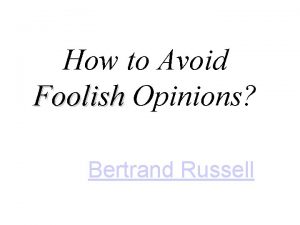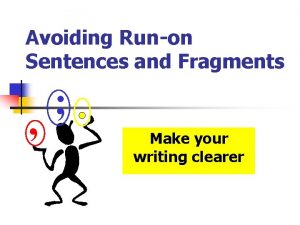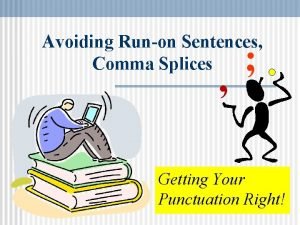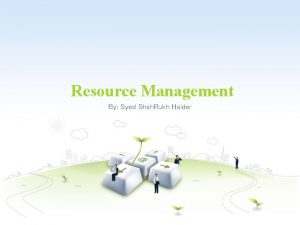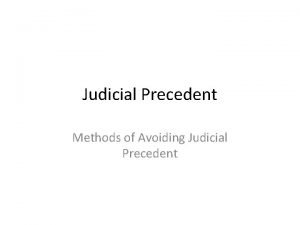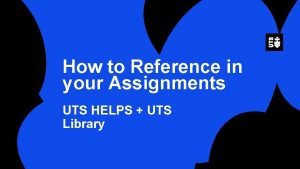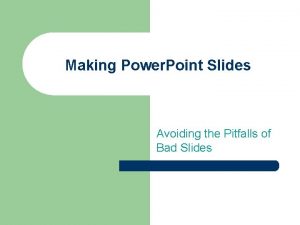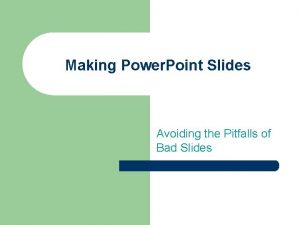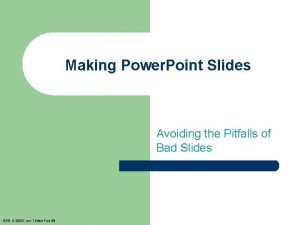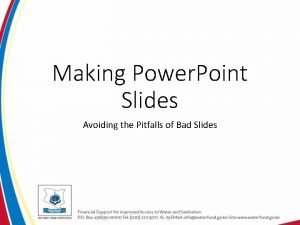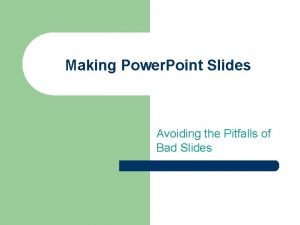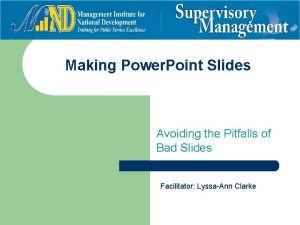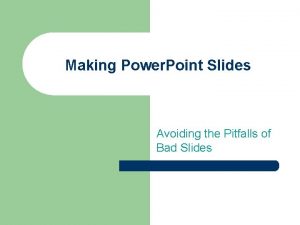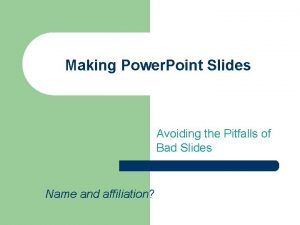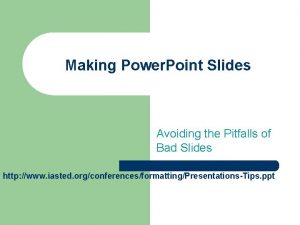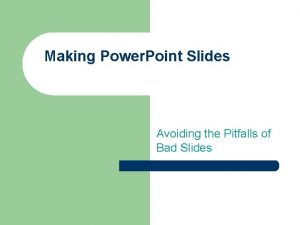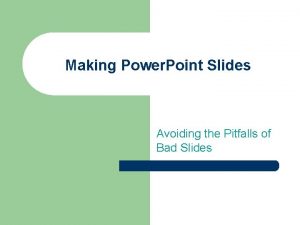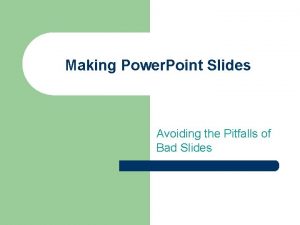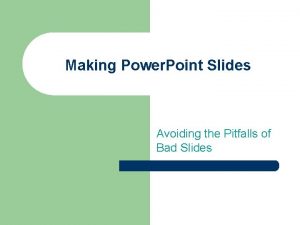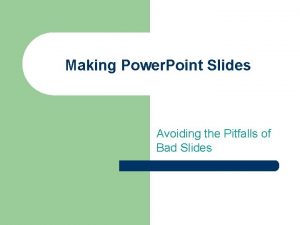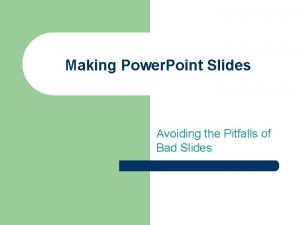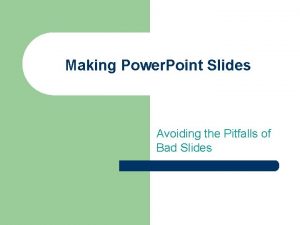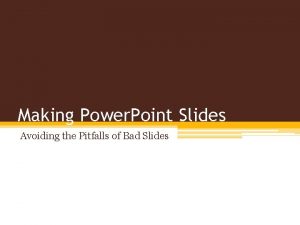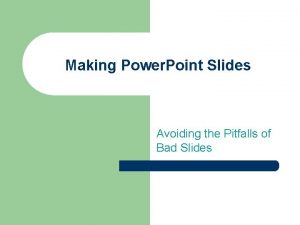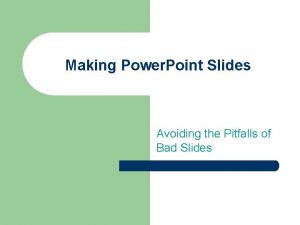Making Power Point Slides Avoiding the Pitfalls of























- Slides: 23

Making Power. Point Slides Avoiding the Pitfalls of Bad Slides By Maysoon Allawi Saleem

Topics to be Covered n n n Outlines Presentation Structure Slide Structure Fonts Colour Background n n n Graphs Spelling and Grammar Conclusions Questions General Information

Outline n Make your 2 nd slide an outline of your presentation n Ex: previous slide Follow the order of your outline for the rest of the presentation Only place main points on the outline slide n Ex: Use the titles of each slide as main points

Presentation Structure n n Use 1 -2 slides per minute of your presentation Don’t copy & paste slides from different sources. Have more images in your slides than text. Consistently use the same font face and sizes on all slides of presentation.

Slide Structure – Good n n Write in point form, (key words and phrases) not complete sentences Include 4 -5 points per slide

Slide Structure - Bad n This page contains too many words for a presentation slide. It is not written in point form, making it difficult both for your audience to read and for you to present each point. Although there are exactly the same number of points on this slide as the previous slide, it looks much more complicated. In short, your audience will spend too much time trying to read this paragraph instead of listening to you.

Slide Structure – Good n Show one point at a time: n n n Will help audience concentrate on what you are saying Will prevent audience from reading ahead Will help you keep your presentation focused

Slide Structure - Bad n Do not use distracting animation n Do not go overboard with the animation n Be consistent with the animation that you use

Fonts - Good n n Use at least an 18 -point font Use different size fonts for main points and secondary points n n this font is 28 -point, the main point font is 32 -point, and the title font is 44 -point Use a standard font like Times New Roman or Arial

Fonts - Bad n n n If you use a small font, your audience won’t be able to read what you have written CAPITALIZE ONLY WHEN NECESSARY. IT IS DIFFICULT TO READ Don’t use a complicated font

Color - Good n Use a color of font that contrasts sharply with the background n n Use color to reinforce the logic of your structure n n Ex: blue font on white background Ex: light blue title and dark blue text Use color to emphasize a point n But only use this occasionally

Colour - Bad n n n Using a font colour that does not contrast with the background colour is hard to read Using colour for decoration is distracting and annoying. Using a different colour for each point is unnecessary n n Using a different colour for secondary points is also unnecessary Trying to be creative can also be bad

Background - Good n n n Use backgrounds such as this one that are attractive but simple Use backgrounds which are light Use the same background consistently throughout your presentation

Background – Bad n n Avoid backgrounds that are distracting or difficult to read from Always be consistent with the background that you use

Graphs - Good n Use graphs rather than just charts and words n n n Data in graphs is easier to comprehend & retain than is raw data Trends are easier to visualize in graph form Always title your graphs

Graphs - Bad

Graphs - Good

Graphs - Bad

Graphs - Bad n n n Minor gridlines are unnecessary Font is too small Colours are illogical Title is missing Shading is distracting

Spelling and Grammar n Proof your slides for: n n speling mistakes the use of of repeated words grammatical errors you might have make If English is not your first language, please have someone else check your presentation!

Conclusion n Use an effective and strong closing n n Your audience is likely to remember your last words Use a conclusion slide to: n n Summarize the main points of your presentation Suggest future avenues of research

Questions? ? n End your presentation with a simple question slide to: n n n Invite your audience to ask questions Provide a visual aid during question period Avoid ending a presentation abruptly

General information n n Know your slides inside out. Never read your slides, Speak freely. Speak with confidence – loud and clear. Don’t speak too fast. Maintain eye contact with the audience.
 Decision making pitfalls
Decision making pitfalls A small child slides down the four frictionless slides
A small child slides down the four frictionless slides John pushes hector on a plastic toboggan
John pushes hector on a plastic toboggan Main theme of how to avoid foolish opinions
Main theme of how to avoid foolish opinions Demographic parity
Demographic parity Competing shark
Competing shark Avoiding run on sentences
Avoiding run on sentences Avoiding insider trading training
Avoiding insider trading training Avoiding fragments and run-ons
Avoiding fragments and run-ons Bed making principles
Bed making principles Glencoe health chapter 12
Glencoe health chapter 12 Owl fox teddy bear shark turtle
Owl fox teddy bear shark turtle Avoiding run on sentences
Avoiding run on sentences Hr department structure
Hr department structure Methods of avoiding precedent
Methods of avoiding precedent Adler first born theory
Adler first born theory What's the best strategy for avoiding atm fees?
What's the best strategy for avoiding atm fees? Complete the introduction giving advice on avoiding
Complete the introduction giving advice on avoiding Uts apa referencing
Uts apa referencing Avoiding the sun
Avoiding the sun A national policy of avoiding involvement in world affairs
A national policy of avoiding involvement in world affairs Power triangle formula
Power triangle formula Power bi power point
Power bi power point Point point power
Point point power



